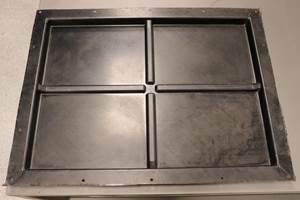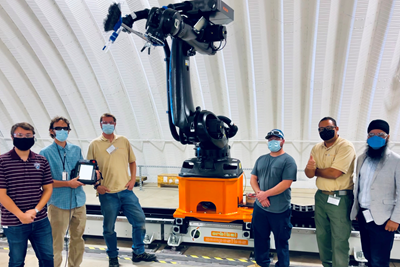Orbital Composites licenses AMCM technology
Additive manufacturing compression molding (AMCM), co-developed with ORNL, combines robotic AM and continuous fiber technologies to revolutionize high-volume composites manufacturing.
Jennifer Granholm, secretary, U.S. Department of Energy (DOE), seeing a live demo of the AMCM technology at ORNL. Photo Credit, all images: Orbital Composites
Orbital Composites (Campbell, Calif., U.S.), developing robotic additive
manufacturing (AM) of continuous fiber-reinforced composites, has announced the exclusive licensing of a new technology co-developed with Oak Ridge National Laboratory (ORNL, Knoxville, Tenn., U.S.). Called additive manufacturing compression molding (AMCM), Orbital says the technology is set to revolutionize the aerospace, mobility and energy industries by offering a new level of speed, efficiency and cost-effectiveness to the composites manufacturing process.
The most demanding applications often require the use of composites, but the cost of manufacturing composite parts has been a barrier to wider adoption. AMCM technology addresses this challenge by significantly reducing the time and cost associated with traditional manufacturing methods, while improving the quality of the final product. This agreement enables Orbital to commercialize AMCM and accelerate decarbonization efforts in aerospace, mobility and energy verticals.
According to Orbital Composites, AMCM combines the benefits of AM with
the precision of compression molding. The technology uses polymer and continuous fiber AM to print directly onto a mold, followed by compression, producing a finished part with high-level accuracy and consistency. AMCM has undergone technology and application validation at ORNL, and has been shown to reduce time and cost associated with traditional manufacturing, while improving the quality of the final product. Through a recent demonstration, ORNL manufactured 100 AMCM parts in five hours, demonstrating <3 minute cycle time per part.
(Left to right): Cole Nielsen, Orbital founder/CTO; Amolak Badesha, Orbital co-founder/CEO; Darrell Stevens, Orbital co-founder/chief engineer); Vipin Kumar, ORNL R&D staff scientist); and Orbital head of automation Anil Kircaliali.
Orbital collaborated with ORNL in building the robotic AM system and incorporated continuous fiber printing into the AMCM process. “We have collaborated with Orbital Composites since 2020, working with their robotic AM platform and are pleased that this partnership has resulted in the licensing of our AMCM process,” Vipin Kumar, R&D staff scientist at ORNL, says. “AMCM combines the fiber control of AM with low porosity of compression molding. This process will enable a high-volume production of next-generation composites that are needed as the automotive industry continues to produce energy efficient vehicles made from lightweight and durable materials.”
Orbital is already well underway in commercializing AMCM for the aerospace and mobility sectors via multiple pilot projects. In a U.S. Air Force funded project, for example, Orbital has demonstrated use of AMCM to manufacture propeller blades for unmanned aerial vehicles (UAVs) in high volume. Similarly, the company has an ongoing project with Oshkosh to demonstrate large-scale AMCM parts, with the aim to cost-effectively manufacture >10,000 parts per year.Other projects are looking into applying AMCM for composite battery boxes.
The project has also received support from the Institute for Advanced Composites Manufacturing Innovation (IACMI, Knoxville, Tenn., U.S.). “The development of the AMCM process is a great example of the power of
partnerships to leverage the IACMI investments to create innovative manufacturing technology in the U.S.,” Chad Duty, IACMI CEO, says.
“Orbital always envisioned combining its innovative robotic continuous fiber AM process with a secondary step for high-volume manufacturing,” Cole Nielsen, founder and CTO of Orbital Composites, adds. “We are especially excited about AMCM since its a zero waste process, and can be scaled to match automotive cycle time requirements.”
In terms of commercialization, Amolak Badesha, co-founder and CEO of Orbital Composites, says the company is already seeing a “strong pull from Tier 1 aerospace and mobility customers.”
Related Content
UniFORM: High-quality, high-complex EV battery enclosures at low cycle times, low tooling costs
Stellantis subsidiary CpK Interior Products Inc. recently completed a design challenge to prove out its vacuum-assisted wet compression molding process for CFRP battery trays.
Read MorePrice, performance, protection: EV battery enclosures, Part 1
Composite technologies are growing in use as suppliers continue efforts to meet more demanding requirements for EV battery enclosures.
Read MorePlant tour: National Institute for Aviation Research, Wichita, Kan., U.S.
NIAR, located at Wichita State University in the heart of the American aerospace manufacturing industry, has evolved to become a premier hub of teaching, R&D, creativity and innovation.
Read MoreCFRTP enables better, greener smartphones
Carbon Mobile’s “monocoque” design eliminates separate case, cover and frame, better protects electronics and simplifies disassembly.
Read MoreRead Next
IACMI receives funding renewal from U.S. DOE to continue composites R&D
Over the next five years, IACMI aims to further composites R&D efforts to support U.S. decarbonization and its pillars: technology, economy and workforce development.
Read MoreOrbital Composites installs robotic manufacturing system at NREL for wind turbine blade research
Customized, automated platform expands NREL’s capabilities for researching blade-finishing technologies and serves as Orbital’s sounding board for applicable composites solutions in aerospace, space and infrastructure.
Read MoreFrom the CW Archives: The tale of the thermoplastic cryotank
In 2006, guest columnist Bob Hartunian related the story of his efforts two decades prior, while at McDonnell Douglas, to develop a thermoplastic composite crytank for hydrogen storage. He learned a lot of lessons.
Read More

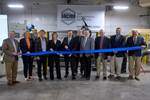
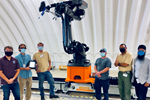

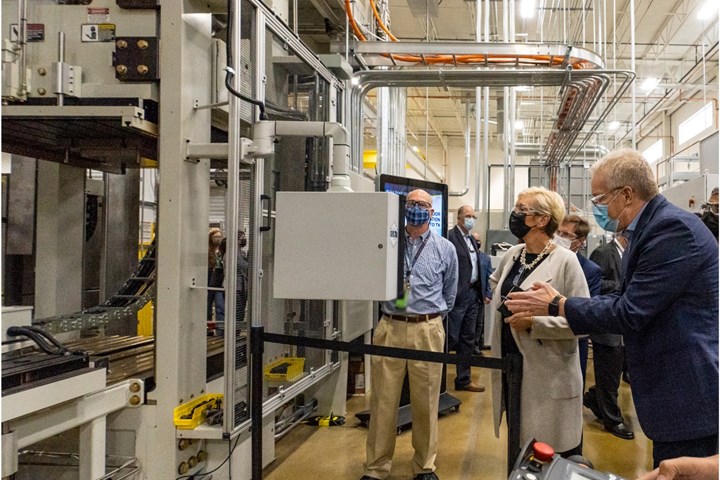













.jpg;maxWidth=300;quality=90)


